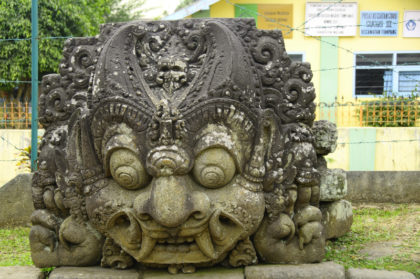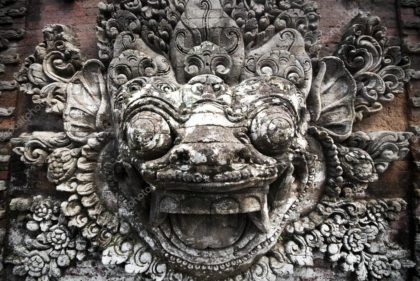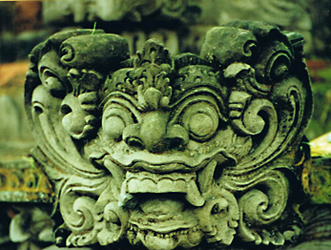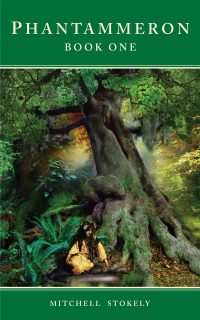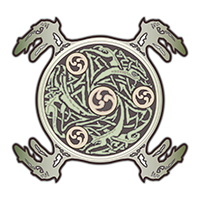In Western culture we have personified the idea of death in myth in many forms; Hades, Thanatos, the Grim Reaper, etc. But in East Asia they have developed a much richer conception.
In Java Mythology we have a much more frightening concept for Time and Death in the form of a being called Kala. He comes from an earlier prototype found in Regvedic Hindu myth, the original form being Yama, the God of the Dead.
Kala for the East Asians was a great demonic giant whose horrible, mouthed-visage covered doors and portals in temples and shrines for thousands of years. He was thus like the Roman Janus or God of Doors, yet with a more spiritual purpose. For Kala was the symbol of the destruction of one’s own spirit which was devoured by Kala as you entered the doors to his temples. His myth was about entering the pits of one’s own unconscious and being fully reborn from its ashes, like Vishnu. For Kala personified the timeless tragedy of our cyclical universe which itself would someday be utterly destroyed by Kala as would Time itself. The idea of using this image in stone gateways thus connects architecture with the personal and universal spiritual journey, which I find fascinating and powerful.
But these ancient cultures, unlike the West, saw death as but a gateway to rebirth, not Heaven or eternal damnation. It wasn’t the end but a new beginning for our timeless spirit through death. And so Kala forms a very complex being born of Time and Change itself, frightening and yet welcoming to the initiate that walked into the spiritual city of Borobudur in Java, and climbed the great stone city from the jungle floor into the misty shrine of Buddha that lay at the summit.
We thus see that Mythology can be an amalgam of beliefs that supersedes religion. Hinduism and Buddhism thus can merge, like Christianity and Capitalism, into a new myth. Yet all these things must ultimately serve mythology, the culture, and our personal brain’s need to find meaning.
I’ve developed many of the characters in the Phantammeron books from both Western ideas as well as Asian and Hindu spiritual ones. In my books, I developed a similar being called Yana the Magra Mother or Oversoul, who is a violent storm sent to destroy the limitless forest called Phantaia. At the end it’s the Sacred Waters she devours that allows her to implode and destroy her own storm clouds through her own unlimited appetite, thereby releasing her waters into the forest to give it new life after she destroyed it. That is very much the ‘Kala ideal’. That rebirth theme, of life from violent evil and death, comes from the Eastern view of Eternal Recurrence as well as the Resurrection of Christ….a combination of the two ideas or two very different yet similar cultures. But the Hindu and Java Batara Kala was my main inspiration for that being. (The thousands of Gods and creatures coming in my later books are also inspired by similar myths.)
This is why it’s so critical as writers we look beyond our own culture for ways in which other people have used their mind’s imagination and spiritual insight to see the deeper and darker symbols that lie embedded in our shadowy unconscious.
It’s why, as we write stories and mythopoeia, we should look beyond the shallow stereotypes of American culture with its fallen hero worship of athletes and entertainers, and it’s vapid consumerism tied to the corporate mythology of happiness tied to product worship. Instead, we must always look to the past and see in mythology a framework of myths, images, and ideas to inspire us towards a much richer “living experience”.
All these frightening images are simply parts of our mind’s vast limitless symbology waiting to be rediscovered and enhanced. But it’s up to us to revisit what our ancestors found in the vast unknown waters of the Self and use them to create even greater spiritual works in and of our own time.
– the Author
#kala #mythopoeia
